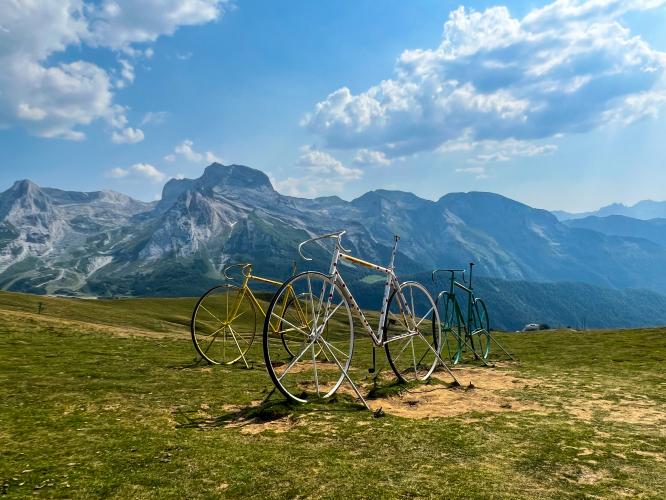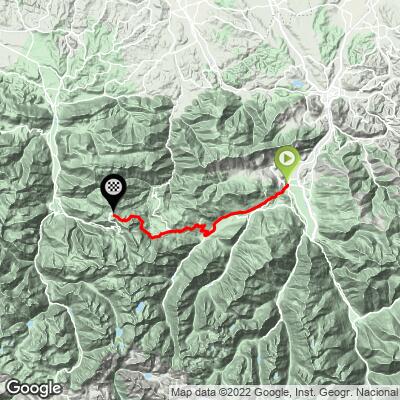![]()
Cycling Col d’Aubisque from Argeles Gazost
Ride 29 kilometers gaining 1,560 meters at average grade 4.2% (6.7% climb only).
Visit our 2022 Tour de France Page. Col d’Aubisque TdF history is at the bottom of this page.
Col d’Aubisque is famous because of it’s long inclusion in the Tour de France, dating back to 1910 when tour organizer Henri Desgrange decided to include mountains in the race. Thus, on Stage 10, July 21, 1910, the Circle of Death was coined as riders were confronted with 4 mountain climbs (Col du Peyresourde, Col d’Aspin, Col du Tourmalet and, finally, Col d’Aubisque) over the course of 326 kilometers between Luchon and Beyonne (see more Aubisque Tour history,
below).
![]()
Beginning of the climb is in Argeles Gazost.
This is the longest and, in our opinion, because of the epic section of cliff and tunnel between Col du Soulor and Col d’Aubisque, the most epic of 2 amazing ascents to Col d'Aubisque. Of course, you get the best of both worlds by riding from Argeles Gazost to the Col, then down to Laruns and back up from that side. This is a wonderful out and back of about just under 100 kilometers and about 3,100 meters gained.
![]()
We enter Arrens at approximately 12 kilometers.
It is 7 kilometers from Arrens at 8% to Col du Soulor.
![]()
Leaving Arrens
![]()
Official Col du Soulor climb begins just after passing Arrens, 7 kilometers from the Col.
Photos in sequence clockwise from top left.
![]()
Col du Soulor is at the 19.5 kilometer mark.
![]()
Sign just after the 2.8 km descent from Col du Soulor and scenes between the 2 cols.
We descend 170 meters at -6%.
![]()
There are some kilometer markers (not every kilometer as of 2018). The official start of the Col d’Aubisque route is actually before the end of the descent from Col du Soulor, at 21.6 kilometers and 7.5 km from Col d’Aubisque at an average grade of 4.1%.
![]()
The cliff begins at about the 22.5 kilometer point and runs just under 2 kilometers.
![]()
Top right photo: bikeraceinfo.com ; Bottom right: Edwin Seldenthus as published in velopeloton.com.
Center and left photos: PJAMMCycling
![]()
Tunnel at 23 kilometers.
![]()
Memorial to former president of Béarnais Cyclo Club.
Bach lost an arm in WWI yet would climb Col d’Aubisque by bike until his death in 1945.
![]()
There is a monument and col sign marking the finish of this grand climb.
![]()
There are 3 giant bicycles just past the col sign and monument.
TOUR DE FRANCE HISTORY
TOP 10 MOST FREQUENT CLIMBS OF THE TOUR DE FRANCE
AND 10 FAMOUS ONES AFTER THAT
Col d’Aubisque is tied with Col d’Aspin for all-time second most TdF appearances.
© PJAMMCycing.com
The Col d’Aubisque bike climb is one of the most famous climbs in the French Pyrenees and France. Aubisque first appeared in the Tour de France in 1910, and as of 2022 has been included 73 times. The climb was included twelve years straight after its post-war inauguration in 1947, and has been a stage finish three times, which is fairly significant for a pass. For the 24 years between 1947 and 1970, the Aubisque was included in the Tour all but three years. The pass was also included once (2016) in the Vuelta a Espan֘a.
![]()
Stage 10 TdF 1911.
Photo: bikeraceinfo.com (an exceptional resource for all Grand Tours).
We rode this route in 2011 and 2018 . . . guess what . . . still the same. 👍
![]()
Same cliff, same mountain, same tunnel (as pictured above) over 100 years later.
Aubisque is our choice for Top TdF Nostalgic Climb.
The descent from Eaux Bonnes (western approach) towards Col du Soulor was and is a dangerous route - it’s a narrow road with sheer cliffs. On Stage 13, July 17, 1951, this hazardous stretch of road was the scene of one of the most horrific and famous crashes in Tour history. The unlikely leader on this day was the pleasant and good natured Dutchman Wim van Est. This Tour included pure and true cycling legends Gino Bartali, Fausto Coppi, and Louison Bobet, and, while an accomplished pursuit racer, van Est was never expected to compete for the overall classification in the greatest of the Grand Tours. Nonetheless, on July 26, during Stage 12, van Est, who started the day over nine minutes behind leader Roger Levêque, broke away and won the stage, finding himself in the yellow jersey by :02:29.
![Col d'Aubisque from Argeles Gazost Cycling Col d'Aubisque from Argeles Gazost - aerial drone photo from ravine of roadway and tunnel]()
A deadly road.
However, winning the flat Stage 12 by using his specialty sprint to gain time on the peloton is one thing, but a sprinter holding a slim lead over the Aubisque would be quite another. And so it was that Van Est had lost his lead as he summited the mighty Aubisque and set about to regain some of what he had lost. However, the narrow and windy road descending from Col d’Aubisque towards Col du Soulor is a poor choice for downhill heroics. And so it was that fell and tumbled 70 meters down and nearly sheer mountainside. It was not just the fall that remains in our memories from this day, but the way Van Est was extricated from his predicament and that he was still alive and able to climb up the mountain back to the road under his own power.
![]()
Photo: Edwin Seldenthus as published in velopeloton.com.
Here is amazing YouTube footage of the rescue of Wim van Est. He was helped up the mountainside by a chain of tires strung together by spectators and his support team. Still alive and unbelievably without major injury, Van Est insisted on continuing the race, but was convinced by wiser authority to go to the hospital.
Making lemonade out of lemons (or $ out of near death?) -- when he flew off the Aubisque cliff, Van Est fortuitously (in hindsight anyway) was wearing a team issued Pontiac wrist watch which became the launching point for Van Est focused advertising campaign with this slogan: “Seventy meters deep I dropped, my heart stood still but my Pontiac never stopped.”
![]()
All the greats have raced on the Aubisque
Louison Bobet, Stage 11 1954 TdF (champion 1953-1955)
Photo: bikeraceinfo.com
The Aubisque has a rich TdF history that began with its very first appearance in The Tour. For the 1910 Tour, legendary TdF organizer, Henri Desgrance, decided to include Peyresourde, Aspin, Tourmalet and Aubisque climbs, as well as three smaller ones on Stage 10 (insane!) - this later became known as The Circle of Death. The first rider over Col du Tourmalet on July 21, 1910 was eventual 1910 tour winner Frenchman Octave Lapize. Lapize was overtaken on the next climb (Col d’Aubisque) and as he reached its summit he unleashed on tour organizers - this is not disputed - what he said, however, is variously reported as either some or all of the following: “murderers,” “assassins,” and/or “criminals.” The french version is most commonly reported asVous êtes des assassins!" which translates to “You are murderers.” Sadly, Lapize was to die seven years later from injuries sustained when his fighter plane was shot down during WWI.
![Octavio Lapize - first cyclist over Tourmalet - 1910]()
Octave Lapize -- the first rider (hiker?) over Tourmalet, 1910.
Photo: Cycling Passion, Octave Lapize walks over the Col du Tourmalet.

 We've partnered with Sherpa-Map.com to bring you the best route planning tool. With a PRO Membership you can use this climb as a reference when creating your route.
We've partnered with Sherpa-Map.com to bring you the best route planning tool. With a PRO Membership you can use this climb as a reference when creating your route. 


